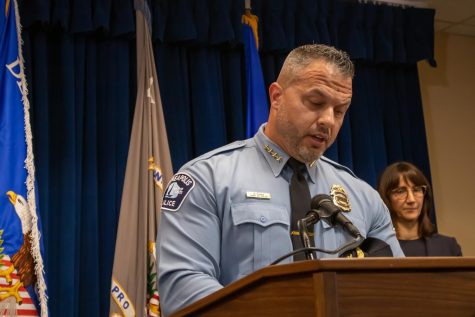Minneapolis Police Chief Brian O’Hara held a press conference Friday, releasing bodycam footage from the May 30 shooting that left officer Jamal Mitchell and three others, including the shooter, dead and the police shooting of an armed man on June 12.
As of Friday, both shootings are still under criminal investigation by the Bureau of Criminal Apprehension.
Officers Luke Kittock and Nicholas Kapinos were identified in the video as having used deadly force in the May 30 shooting. The second video identified officers Chaz Wilson, Enoch Langford and Abdiurizaq Mumin in the June 12 shooting.
Officers involved in the June 12 shooting ordered the man, Michael Warren Ristow, to drop his weapon. When he did not, the three officers fired several shots, hitting Ristow and dropping him to the ground. Ristow died in the hospital.
In both shootings, the recovered firearms jammed, according to O’Hara. The gun used in the May 30 shooting jammed after it was used to shoot Mitchell and two others.
O’Hara said he believed the actions taken by the police officers in both incidents were responsible, necessary and courageous, and he is thankful for the level of training exhibited by the officers involved in these shootings. He added that the increase in firearms on the street since June 2020 has put the Minneapolis community in danger.
O’Hara said MPD has taken over 1000 illegal firearms off the street each of the last two years, and there have been reports of up to two dozen stolen firearms a week in Minneapolis.
Under Minnesota law, bodycam footage from fatal police shootings must be released within 14 days of the incident, according to O’Hara. The BCA requested footage from the May 30 incident be withheld, as releasing the footage earlier may have hindered their investigation, O’Hara added.
O’Hara said the footage from the June 12 shooting was released alongside the May 30 footage to ensure the footage was released as quickly as possible.
“My approach has been, and will always be, to make these videos available as soon as we possibly can, as fast as is appropriate,” O’Hara said.
O’Hara said people often fail to understand the complexities of armed shooter situations, and people rarely hear about incidents with armed suspects that do not end fatally.
“The officers have to act as quickly as possible and make decisions as quickly as possible,” O’Hara said. “We’ve seen in episodes around the country where officers have not done that in active shooter situations and there’s been very deadly consequences and the officers are called cowards after the fact.”














